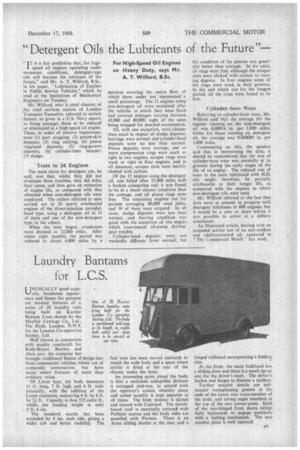"Detergent Oils the Lubricants of the Fu - ture"—
Page 39

If you've noticed an error in this article please click here to report it so we can fix it.
For High-Speed Oil Engines on Heavy Duty, says Mr. A. T. Wilford, B.Sc. " IT is a fair prediction that, for high 1 speed oil engines operating under strenuous conditions, detergent-type oils will become the lubricant of the future," said Mr. A. T. Wilford, B.Sc., in his paper, "Lubrication of Engines in Public Service Vehicles," which he read at the Institution of Mechanical Engineers on Tuesday.
Mr. Wilford, who is chief chemist of the road services section of London Transport Executive, referred to certain factors, as given in a U.S. Navy report. as being amongst those to be reduced or eliminated in a high-speed oil engine. These, in order of relative importance, were (I) port clogging; (2) piston-skirt deposits; (3) ring sticking; (4) piston ring-land deposits; (5) ring-groove deposits; (6) cylinder-liner lacquer; (7) sludge.
Tests in 24 Engines
The main claim for detergent oils, he said, was that, whilst they did not eliminate these troubles, they did delay their onset, and thus gave an extension of engine life, as compared with that obtained when non-detergent oils were employed. The author referred to tests carried out in 24 newly overhauled engines of the direct-injection toroidalhead type, using a detergent oil in 12 of them and one of the non-detergent type in the others.
'When the tests began, crankcases were drained at 12,000 miles. After about eight months, the period was reduced to about 6,000 miles by a decision covering the entire fleet, of which those under test represented a small percentage. The 12 engines using non-detergent oil were examined after the vehicles in which they were fitted had covered mileages varying between 42,000 and 80,000, eight of the units being stripped for detailed examination.
All, with one exception, were cleaner than usual in respect of sludge deposits. bearings were normal and'cylinder-head deposits were no less than normal. Piston deposits were average, one or more compression rings were stuck or tight in two engines, scraper rings were stuck or tight in four engines, and in all instances, scraper slots were heavily choked with carbon.
Of the 12 engines using the detergent oil, one failed after 25,000 miles with a broken connecting rod; it was found to he in a much cleaner condition than the average, and all piston rings were free. The remaining engines ran for periods averaging 80,000 road miles, and 10 of them were stripped. In all cases, sludge deposits were less than normal, and bearing condition was good with the exception of one engine which experienced oil-pump drivinggear trouble.
Cylinder-head deposits were not markedly different from normal, but
the condition of the pistons was generally better than average. In six units, all rings were free, although the scraper slots were choked with carbon to varying degrees. In four engines some of the rings were stuck in their grooves. In the unit which ran for the longest period, all the rings were found to be free.
Cylinder-bore Wear .
Referring to cylinder-bore wear, Mr. Wilford said that the average for the engines running on the non-detergent oil was 0.00016 in. per 1,000 miles, whilst for those running on detergent oil, the average was 0.000089 in. per 1,000 miles.
Commenting on this, the speaker said that in interpreting the data, it should be remembered that the rate of cylinder-bore wear was normally at its greatest during the early stages of the life of an engine. The reduced rate of wear in the units lubricated with H.D. oils might, therefore, be partially attributable to their longer life, as compared with the engines in which non-detergent oils were used.
Mr. Wilford referred to the fact that tests were at present in progress with detergent lubricants in 600 engines, but it would be a year or more before it was possible to arrive at a definite conclusion.
An illustrated article, dealing with an extended service test of an anti-oxident and additive-treated oil, appeared in "The Commercial Mot& " last week.




























































































